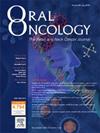CD168在早期口腔鳞状细胞癌中的流行及预后价值
IF 4
2区 医学
Q1 DENTISTRY, ORAL SURGERY & MEDICINE
引用次数: 0
摘要
目的vecd168已被确定为多种肿瘤实体预后不良的阴性预后标志物。对于OSCC,缺乏全面的研究来检验CD168表达与临床结果之间的相关性,阻碍了这一预后因素在临床实践中的应用。材料和方法本回顾性分析包括所有原发性pT1和pT2 pN0 OSCC患者,这些患者接受手术治疗,无需辅助治疗(pN0, M0, R0),时间长达7年。CD168和Mib/Ki67的免疫组织化学染色使用原发肿瘤的组织微阵列进行评估,并与临床结果相关。CD168表达的临界值≥10%被认为是阳性。结果共纳入139例患者,其中男性91例(65.5%),女性48例(34.5%),平均年龄61.2岁,平均随访时间62.6个月。CD168在35例(25.2%)肿瘤中明显表达,导致Mib/Ki67阳性水平升高(p <;0.001)。与T1期肿瘤相比,T2期肿瘤活检CD168阳性的频率更高(p = 0.002)。CD168表达≥10%的肿瘤OS明显降低(p <;0.001)和RFS (p = 0.011)。多因素Cox回归发现CD168状态是OS的危险因素(HR 2.10, CI: 1.06-4.14;p = 0.033)。结论我们的研究结果表明,cd168阳性肿瘤在OSCC中占很大比例,并提示其影响预后,特别是在OS方面。本文章由计算机程序翻译,如有差异,请以英文原文为准。
The prevalence and prognostic value of CD168 in early-stage oral squamous cell carcinoma
Objective
CD168 has been established as a negative prognostic marker in various tumor entities leading to a poor prognosis. Regarding OSCC, there is a lack of comprehensive studies that examine the correlation between CD168 expression and clinical outcome, hindering the implementation of this prognostic factor into clinical practice.
Materials and Methods
This retrospective analysis included all patients with primary pT1 and pT2 pN0 OSCC who received surgical therapy without the need for adjuvant therapy (pN0, M0, R0) over a seven-year long period. Immunohistochemical staining for CD168 and Mib/Ki67 was evaluated using tissue microarrays of primary tumors and correlated with clinical outcome. A cut-off value for CD168 expression of ≥10 % was considered as positive.
Results
A total of 139 patients (male: 91 (65.5 %), female: 48 (34.5 %)) with a mean age of 61.2 years were included (mean follow-up: 62.6 months). CD168 expression was evident in 35 (25.2 %) tumors leading to higher levels of Mib/Ki67 positivity (p < 0.001). Tumor biopsies of stage T2 OSCC stained positive for CD168 more frequently when compared to T1 tumors (p = 0.002). Tumors with CD168 expression ≥ 10 % had a significantly lower OS (p < 0.001) and RFS (p = 0.011) compared to patients with lower expression. Multivariate Cox regression identified CD168 status as a risk factor for OS (HR 2.10, CI: 1.06–4.14; p = 0.033).
Conclusion
Our results demonstrate a significant proportion of CD168-positive tumors in OSCC and suggest an impact on prognosis, particularly with regard to OS.
求助全文
通过发布文献求助,成功后即可免费获取论文全文。
去求助
来源期刊

Oral oncology
医学-牙科与口腔外科
CiteScore
8.70
自引率
10.40%
发文量
505
审稿时长
20 days
期刊介绍:
Oral Oncology is an international interdisciplinary journal which publishes high quality original research, clinical trials and review articles, editorials, and commentaries relating to the etiopathogenesis, epidemiology, prevention, clinical features, diagnosis, treatment and management of patients with neoplasms in the head and neck.
Oral Oncology is of interest to head and neck surgeons, radiation and medical oncologists, maxillo-facial surgeons, oto-rhino-laryngologists, plastic surgeons, pathologists, scientists, oral medical specialists, special care dentists, dental care professionals, general dental practitioners, public health physicians, palliative care physicians, nurses, radiologists, radiographers, dieticians, occupational therapists, speech and language therapists, nutritionists, clinical and health psychologists and counselors, professionals in end of life care, as well as others interested in these fields.
 求助内容:
求助内容: 应助结果提醒方式:
应助结果提醒方式:


